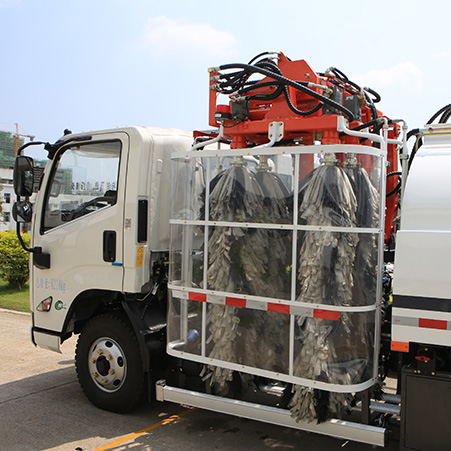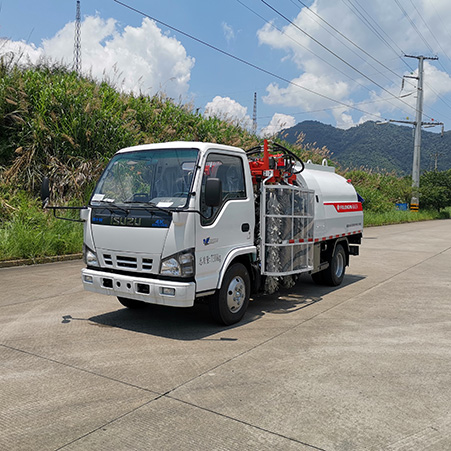Guardrail cleaning trucks are specialized vehicles with advanced cleaning systems designed to maintain and clean guardrails along highways and roads. These trucks are essential for removing dirt, debris, graffiti, and other contaminants that accumulate on guardrails over time. By keeping guardrails clean, these trucks help ensure that they remain effective in enhancing road safety.
Importance of Guardrail Maintenance
Guardrails are vital for road safety, acting as barriers that prevent vehicles from veering off the road, especially in dangerous areas like sharp curves or steep drop-offs. However, guardrails can only perform this function effectively if they are well-maintained. Dirty, rusted, or damaged guardrails can compromise safety and even pose additional hazards.
- Safety Considerations: Clean guardrails are easier to see and more likely to function correctly in an accident, reducing the risk of severe damage or injury.
- Aesthetic and Environmental Impact: Regular cleaning helps maintain the visual appeal of roads and highways and prevents environmental contamination from rust and debris.
- Regulatory Compliance: Many regions have strict regulations regarding road maintenance, including the condition of guardrails. Regular cleaning helps meet these standards.
Types of Guardrail Cleaning Trucks
Guardrail cleaning trucks come in various types, each suited to specific cleaning needs and conditions. Let’s look at the primary types:
- Vacuum Trucks: These trucks use powerful vacuum systems to suck up debris, dirt, and other loose materials from the guardrails. They are particularly effective in removing dry, loose particles.
- Pressure Washing Trucks: Equipped with high-pressure water jets, these trucks blast away grime, graffiti, and stubborn dirt from the guardrails. They are ideal for deep cleaning and removing tough contaminants.
- Combination Trucks: Some trucks combine vacuum and pressure washing systems, offering a versatile solution that can handle various cleaning tasks.
Key Components of Guardrail Cleaning Trucks
To understand how these trucks work, let’s break down their key components:
- Water Tanks: These tanks store large amounts of water used for pressure washing. The capacity and material of the tanks vary depending on the truck’s design and purpose.
- Pressure Systems: These systems generate and control the high-pressure water jets used for cleaning. They include pumps, hoses, and nozzles designed to deliver powerful streams of water.
- Vacuum Systems: These consist of powerful motors and filters that create suction to remove dirt and debris from the guardrails. The collected material is stored in onboard tanks for later disposal.
- Brushes and Nozzles: Various types of brushes and nozzles are used to scrub and spray the guardrails. These are often adjustable to handle different cleaning tasks and guardrail designs.
Mechanics and Technology
The mechanics behind guardrail cleaning trucks are a blend of engineering and innovation:
- Engine and Power Systems: These trucks are equipped with robust engines that provide the necessary power to operate both the vehicle and the cleaning equipment. Diesel engines are common due to their reliability and power output.
- Hydraulic Systems: Hydraulics play a crucial role in operating the cleaning equipment, especially in lifting and positioning the brushes and nozzles.
- Control Systems: Modern guardrail cleaning trucks feature advanced control systems that allow operators to manage the cleaning process with precision. These systems often include user-friendly interfaces and automated features.
- Automation and Efficiency: Some trucks come with automated features that enhance efficiency, such as automated nozzle adjustments and programmable cleaning cycles. These innovations reduce the need for manual intervention and improve overall productivity.
Operational Procedures
Operating a guardrail cleaning truck involves several key steps:
- Preparation: Before starting, operators conduct a thorough inspection of the truck and its equipment. This includes checking fluid levels, ensuring all systems are functioning correctly, and planning the cleaning route.
- Execution: The cleaning process begins with positioning the truck alongside the guardrail. Operators then activate the cleaning systems, adjusting brushes and nozzles as needed. The truck moves slowly along the guardrail, systematically cleaning each section.
- Safety Protocols: Safety is paramount. Operators follow strict safety protocols to protect themselves and other road users. This includes using warning signs, wearing protective gear, and adhering to traffic regulations.
Conclusion
Guardrail-cleaning trucks are indispensable tools in the realm of road maintenance. By keeping guardrails clean and functional, these specialized vehicles play a crucial role in ensuring road safety and maintaining the aesthetic and environmental quality of our highways. From their sophisticated mechanics and technology to the careful operational procedures, guardrail cleaning trucks exemplify the blend of engineering and innovation that keeps our roads safe and clean.








